Hobyo Grasslands and Shrublands
The ecoregion’s land area is provided in units of 1,000 hectares. The conservation target is the Global Safety Net (GSN1) area for the given ecoregion. The protection level indicates the percentage of the GSN goal that is currently protected on a scale of 0-10. N/A means data is not available at this time.
Bioregion: South Red Sea & Gulf of Aden Coastal Drylands (AT22)
Realm: Afrotropics
Ecoregion Size (1000 ha):
1,348
Ecoregion ID:
95
Conservation Target:
30%
Protection Level:
0
States: Somalia
One of the two strictly endemic mammals in the Hobyo Grasslands and Shrublands ecoregion is the silver dikdik, restricted to a narrow strip along the central coastal plain of Somalia that extends no more than 10 km inland. They inhabit very low, dense thickets which flourish on the fertile, sandy soils along the coast. At an estimated population of 30,000, the dikdiks are under pressure from the increasing human population in the coastal region.
The ecoregion covers a long, narrow coastal strip in Somalia, extending from just south of Mogadishu near the town of Merka northwards to 250 km north of Hobyo. The dunes reach heights of 160 m, and the dune field is about 10 to 15 km wide along its entire length, dominated by perennial grasslands and sedges. There are occasional rocky outcrops, especially in the northern part of the region. The climate is hot and dry.
Temperature varies little during the year, with maximum temperatures reaching 33°C and minimum temperatures dipping to 21°C. Rainfall averages 200 mm annually, with most rain falling within the period from April to June as the Intertropical Convergence Zone (ITCZ) moves north and then south. Vegetation is adapted to the severe climate in several ways.

The flagship species of the Hobyo Grasslands and Shrublands ecoregion is the silver dikdik. Image credit: Creative Commons
Along the coast, bushy vegetation, which is sandblasted by powerful winds, forms a specialized community of low, dense thickets of Aerva javanica, Indigofera sparteola, Jatropha pelargoniifolia (glandulosa), and Tephrosia filiflora. The first colonizers of the dunes are wind tolerant grasses and sedges, such as the near-endemic Cyperus chordorrhizus and the endemic Aristolochia rigida. Thorny, endemic species, such as the 5–6 m tall Solanum arundo, are important features of the shrub.
This ecoregion is part of the Somali-Masai regional centre of plant endemism. Botanical exploration of this region started at the end of the 19th century, but unpredictable rainfall, political instability, and inaccessibility have hindered detailed studies.
There are around 1,000 vascular plant species with high species endemism including many of the cushion plants shaped by the sand-laden winds. Succulents are also common, and the monotypic genus Puntia occurs. Other endemics include Amphiasma gracilicaulis and Gymnocarpos parvibractus. Unusual plant communities grow in moist limestone gorges in the northern part of the region, including the woody Buxus hildebrandtii, Maytenus undata, and Vepris eugeniifolia. These species are otherwise only found in the moister Somali Montane Xeric Woodlands ecoregion. Dirachma somalensis, one of two endangered species in the Dirachmaceae family, is located in limestone gorges.
The overall number of vertebrate species in the ecoregion is relatively low, but these include several endemic and rare species, including two strictly endemic reptiles, Haacke-Greer’s skink and Latastia cherchii. Two strictly endemic mammals are the silver dikdik and the Somali golden mole.
-CC-2014%20copy.jpg)
Gazelle. Image credit: Creative Commons
A number of rare larger mammals also occur: dibatag, Sömmerring's gazelle, and Speke's gazelle. These all have quite restricted ranges in the Horn of Africa. The ecoregion also supports two strictly endemic bird species: Ash's lark and the Obbia lark which are restricted to the coastal fixed-dune grasslands.
Due to the long-standing and continued political instability in Somalia, little is known about the current state of biodiversity in the region. There are no protected areas in Somalia within this ecoregion. It is known that local populations use the scrub and grassland habitats of the ecoregion to graze their animals and gather fuelwood.
The recent political instability and clan warfare in Somalia may have impacted habitats through the displacement of people to the coastal strip from urban centres and from areas further inland.
The priority conservation actions for the next decade will be to: 1) establish protected areas which are effectively and equitably managed and are ecologically representative; 2) encourage alternative livelihoods and income generation through leading training and innovative entrepreneurship activities; and 3) promote research and monitoring in the region to reduce the knowledge gaps.
Citations
1. Burgess, N., Hales, J.A., Underwood, E., Dinerstein, E., Olson, D., Itoua, I., Schipper, J., Ricketts, T. and Newman, K. 2004. Terrestrial ecoregions of Africa and Madagascar: a conservation assessment. Island Press.
2. LaViolette, A. and Wynne-Jones, S. eds. 2018. The Swahili World. In The Swahili World. Abingdon: Routledge.
3. Ullah, S. and Gadain, H. 2016. National Biodiversity Strategy and Action Plan (NBSAP) of Somalia. Somalia: FAO.
4. IUCN SSC Antelope Specialist Group. 2016. Madoqua piacentinii. The IUCN Red List of Threatened Species 2016. [Online]. [Accessed 11 April 2018]. Available from: http://www.iucnredlist.org/details/12667/0





